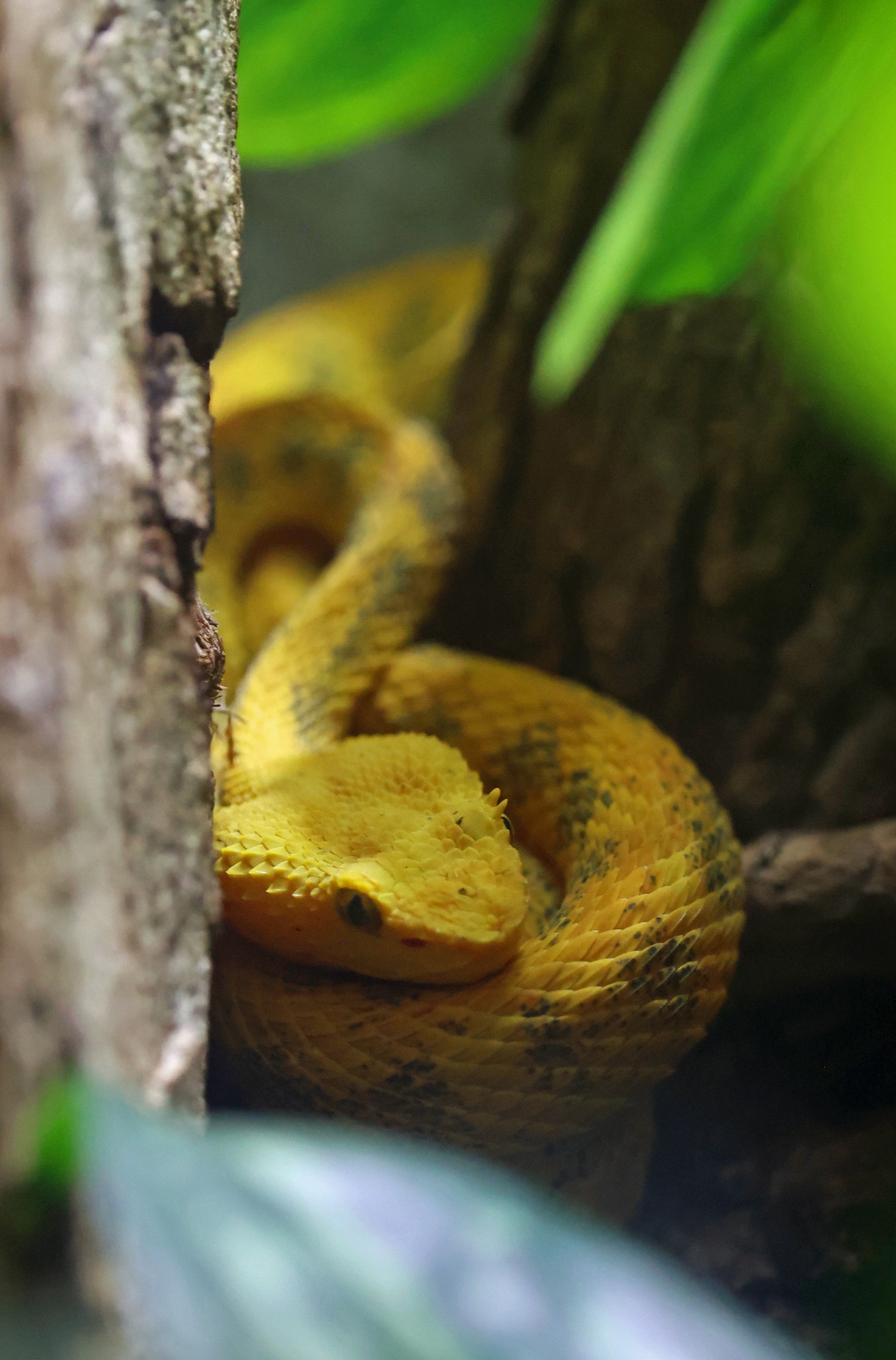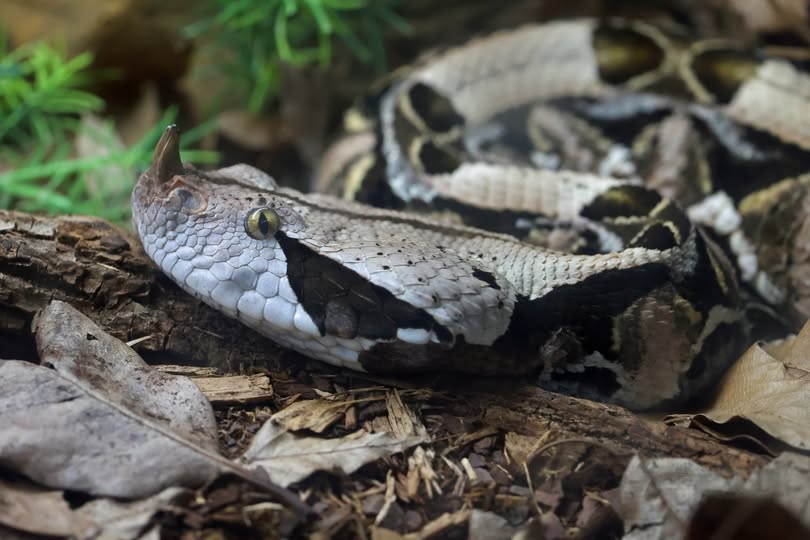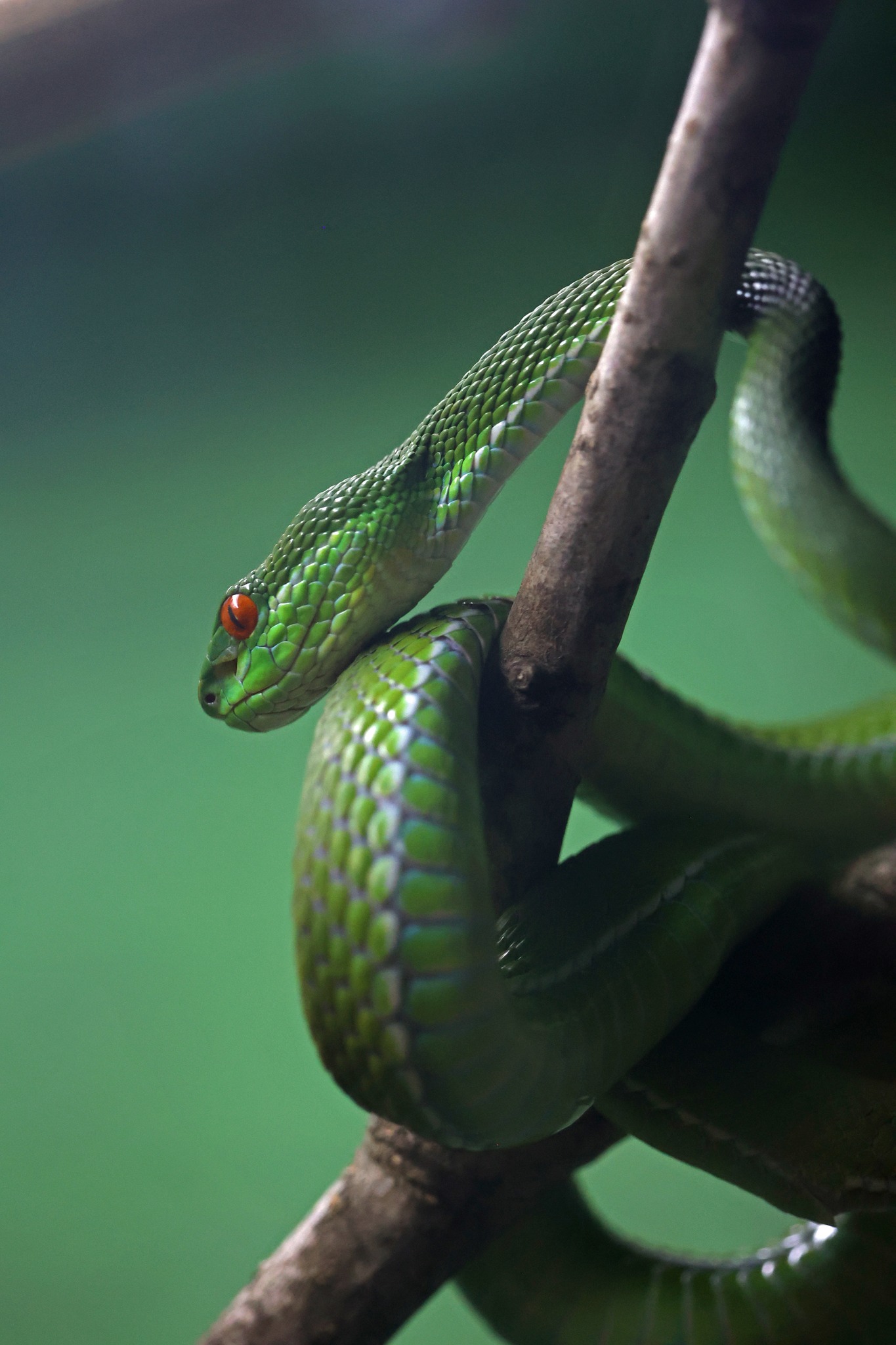Snakes
Snakes are limbless reptiles belonging to the suborder Serpentes, with over 3,000 species found in various habitats around the world. These remarkable animals are known for their elongated bodies, forked tongues, and unique method of locomotion through lateral undulation. Snakes play a vital role in ecosystems as both predators and prey, controlling populations of rodents and other small animals while serving as food for larger predators. Visit these amazing creatures and learn more about them in the Reptile House.




Angolan Python
(Anchieta’s Dwarf Python)
Angolan pythons are reddish brown to black with white markings. They have a yellow belly and five heat sensitive pits on each side of the head.
Habitat/Range:
Found in southern Angola and Namibia, this snake prefers rocky outcrops on mountain terrain or brushy plains.
Size:
Length: 6 feet.
- Due to civil war in Angola, these snakes are rarely found in captivity.
Least Concern. They are used in the international pet trade.
Conservation Action:
These snakes live in some protected areas.
Burmese Python
Burmese pythons are darkly colored, with reddish to brown and dark cream colored rectangles. They have an arrow shaped marking on the top of their head. Males are usually smaller than females.
Habitat/Range:
These snakes prefer tropic and sub tropic areas of south Asia.
Size:
Length: Burmese Up to 24.5 feet. Weight: Burmese Up to 310lbs.
- Burmese pythons can hold their breath for up to 30 minutes!
- Burmese pythons are an invasive species in Florida and are thriving there, even though they are a vulnerable species in their native habitat.
IUCN lists as vulnerable. The main threat to these snakes is the illegal wildlife trade. Their skins are used for decoration, leather and musical instruments. They are also sold as pets and hunted for meat. They are also affected by habitat degradation such as slashing and burning. In Vietnam it is listed as critically endangered.
Conservation Action:
They are a protected species in Vietnam, China, Thailand, and Indonesia. Listed on CITES Appendix II. Where it is invasive in Florida, measures are being taken to control or eradicate the species.
Amazon Tree Boa
The Amazon Tree Boa (Corallus hortulana) is a striking and elusive snake native to the lush rainforests of the Amazon Basin. This arboreal boa is renowned for its vibrant coloration, which varies from bright green to shades of yellow, orange, and red, often adorned with dark patterns. Adapted for life in the trees, the Amazon Tree Boa has prehensile tail that helps it navigate its forest habitat with agility and precision.
Habitat/Range:
Amazon tree boas are found in the Amazon region of South America, including Columbia east of Andes, southern Venezuela, Guyana, Suriname, French Guiana, Ecuador, Peru, Brazil, Bolivia, Trinidad & Tobago, and Costa Rica. They live in forests with high humidity as well as savannas or dry forests.
Size:
Amazon tree boas can grow to be 5–7 ft long, though some have been known to reach 7.25 ft.
- Amazon Tree Boas are primarily nocturnal hunters, preying on small mammals, birds, and reptiles. They use their keen sense of smell and heat-sensing pits to locate prey in the dense forest canopy. Despite their impressive appearance, these boas are non-venomous and rely on constriction to subdue their prey.
- They have heat sensing pits on each side of their face that they use to sense heat when hunting at night.
Considered Least Concern, but susceptible to loss of habitat and removal for pet trade.
Copperhead
Copperheads have reddish-brown bodies covered in a crossband pattern consisting of tan, copper, and rich brown colors that extend throughout the body. Their heads are triangular and a solid brown color. Each subspecies of copperhead has variations in color and pattern. Males are typically longer than females and juveniles are grayer with a yellow-tipped tail.
Range/Habitat:
The southern copperhead range extends through Massachusetts, westward to Texas and southeastern Nebraska. They can inhabit a variety of habitats including forests, wet woodlands, edges of swamps, stream beds and gulches. They can also be found in and around man-made environments.
Size:
Length: 30-53in.
- Copperheads are a venomous snake, however, their venom is somewhat milder compared to other venomous snakes and rarely results in death in a healthy human.
- The yellow-tipped tail on juveniles is thought to help lure small prey. They will move the tail mimicking caterpillar movements, bringing their prey within striking distance.
- Kingsnakes and opossums are reported to be immune to copperhead venom.
Least Concern. Certain areas of the US are experiencing declines in population and they are considered endangered in Iowa and Massachusetts. Their threats include habitat destruction, invasive plants, insecticide application, and road mortality.
Cottonmouth
This venomous snake enjoys being around water and is named for the white lining of its mouth. They have triangular shaped heads, heat sensing pits which help identify warm blooded animals and is found between the eyes and nostrils. Their eyes have vertically slit pupils. They are rough in texture due to their keeled scales which provide ridges on the scales. They are usually olive-brown with paler bellies.
Habitat/Range:
This snake is found in north central Texas and prefers streams, river floodplains, swamps, wetlands and marshes.
Size:
Length: 2-6 feet.
- They vibrate their tails when threatened in order to mimic a rattlesnake.
Least Concern. They are threatened by human activity which includes persecution and habitat loss.
Conservation Action:
In some states, they are protected under native snake laws. They are endangered in Indiana.
Eyelash Palm Pit Viper
Eyelash vipers can be found in a variety of color morphs. They are most commonly olive green but can also be bright yellow, pink, green, silver, dark grey or brown. Faint markings of various colors can be seen on the body. The tips of the tail are yellow or green and their undersides are pale yellow often with darker spots. Habitat directly affects the coloration of these snakes. They are characterized by a prehensile tail used for climbing, a triangular head, and distinctive keeled scales above the eyes that gives them a “browed” appearance. Their scales are ridged to give them a better grip on vegetation. Females tend to be larger than males and juveniles look the same as adults.
Range/Habitat:
Eyelash vipers range from southern Mexico through northwestern Ecuador and western Venezuela. They prefer moist tropical forests but can also be found in woodlands and shrublands both at lower and higher elevations.
Size:
1-2.75 feet.
- Eyelash viper venom is hemotoxic, meaning it destroys red blood cells. The venom also contains procoagulants and haemorrhagins, and affects both the central nervous system and the cardiovascular system.
- Scientists aren’t quite sure what the purpose of the “eyelash” scales are on these snakes. It is thought that they aid in camouflage by breaking up the snakes silhouette and may protect their eyes when moving through thick vegetation.
IUCN has not evaluated this animal and the Convention on International Trade of Endangered Species has removed them from their list. They are most likely threatened by deforestation due to agriculture, urbanization and the timber industry. No fatalities from eyelash vipers has ever been reported. Due to their sometimes yellow coloration, these snakes have accidentally been shipped in banana boxes all over the world.
Banded Rock Rattlesnake
The Banded Rock Rattlesnake (Crotalus lepidus) is a striking species native to the rugged terrains of the southwestern United States and northern Mexico. Known for its distinctive banding patterns and rattle at the end of its tail, this snake is an expert at blending into its rocky environment. Its coloration typically features a mix of gray and brown bands, providing excellent camouflage among the rocks and desert vegetation.
Habitat/Range:
This species is native to the southern U.S. and Mexico, ranging from southeastern Arizona to western Texas and south through northern and central Mexico.
It ranges across a variety of arid and semi-arid habitats, from grasslands and tropical deciduous forests to mountains, rocky flats and outcrops at elevations of 300 to 2,930 meters (1,000 to 9,600 feet).
Size:
Banded rock rattlesnakes are a small- to medium-sized species, typically reaching 60 to 70 centimeters (23 to 27 inches) in length, though some males may exceed 80 centimeters (31 inches). Males tend to be larger than females.
- Banded rock rattlesnakes use venom to subdue their prey before swallowing it whole.
- Banded Rock Rattlesnakes are generally shy and prefer to avoid confrontation. They use their rattle as a warning signal to potential threats, giving them a chance to retreat to safety. Despite their intimidating appearance, these snakes play a crucial role in their ecosystem by controlling rodent populations and maintaining the balance of their habitat.
Minor threats to these snakes include urban development, collection for the pet trade and habitat disruption due to mining activity. This species is common throughout its range and known to occur in protected areas, but population status in the wild is unknown.
Green Tree Python
As their name implies, these snakes are a bright green color. On their back, they have a ridge of scales that are white or yellow that form a broken or continuous line down their backs. Their stomachs are generally yellow. These pythons do have heat sensing pits on their upper lips. Juveniles that are yellow in color are found throughout the range and red juvenile morphs are found in parts of Indonesia and New Guinea. The same clutch can have both red and yellow morphs. The juveniles have white blotches edged in black or brown running down their backs. They also have a white streak edged in black that runs from the nostril, through the eye to the back of the head. When they are young, females are may have longer and wider heads than males of similar size. Some adults may never fully change from their juvenile coloring.
Habitat/Range:
Green tree pythons are found in New Guinea, eastern Indonesia, surrounding islands, and the Cape York Peninsula of Australia. They inhabit tropical rainforest. As juveniles they like to hang out in forest edges or near gaps in the canopy, but as adults they are found in closed-gapped canopy.
Size:
Length: 5 feet, Up to 7 feet.
- Green tree pythons have a prehensile tail to aid them in climbing.
- Juvenile snakes change color around 6 months to 1 year in age. This does not have to do with sexual maturity. Instead, it has to do with length. Once the snake reaches a certain length, it can change its feeding habits. As a juvenile, it lived in forest gaps (where lighter coloring would provide better camouflage) where smaller prey lives. As an adult, they inhabit closed-gap canopy (where green provides more camouflage) where larger prey is found.
IUCN has not determined their status as of yet. They are one of the most common pet snakes. Some of these snakes are captive bred, but others are wild caught. Indigenous people in New Guinea hunt this species for food. They are most likely affected by habitat degradation as well.
Conservation Action:
Listed CITES Appendix II. In Australia it is illegal to capture wild green tree pythons or import them from New Guinea.
McGregor’s Pit Viper
McGregor’s Pit Viper (Trimeresurus mcgregori) is a strikingly beautiful yet elusive species of pit viper found in the forests of the Philippines.
Habitat/Range:
McGregor’s pit viper, also known as the yellow spotted pit viper or Batanes pitviper, lives in the Philippines on the Batanes Islands. Its preferred habitats are forests and shrublands at elevations ranging from sea level to 2,600 ft (800 m), but it has also been found in agricultural areas.
- Recognizable by its vibrant green coloration and distinctive patterns, this venomous snake plays a crucial role in its ecosystem as a predator of small mammals, birds, and insects.
- Pit vipers have infrared receptors, called pit organs, on either side of their head that help them sense warm-blooded animals. These organs are located between the eye and nostril and are covered with a temperature-sensitive membrane. Pit vipers can use these organs to find prey and cool places to hide from the heat during the day.
- Pit vipers are ovoviviparous, which means the female lays eggs that hatch inside her and she gives birth to live young.
Conservation of McGregor’s Pit Viper is important due to habitat destruction and fragmentation affecting its rainforest home. Efforts to protect these habitats and promote awareness about the species are essential for its survival. By supporting conservation initiatives, we contribute to the preservation of the delicate balance of their natural environment and the incredible biodiversity it supports.
Mexican Burrowing Python
Mexican burrowing pythons are dark in color with patches of white scales. However, occasionally almost entirely white snakes can be observed after shedding. They have small eyes, a narrow head, and a shovel shaped snout which is used for burrowing.
Range/Habitat:
The Mexican burrowing python can be found along the Pacific coast of Mexico, down through Guatemala, Honduras, El Salvador, Nicaragua, and Costa Rica. They inhabit a variety of areas including: tropical, moist, and dry forests, mangroves, beaches, as well as dry inland valleys.
Size:
Length: 3-5 feet.
- Mexican burrowing pythons are not in the python family. They belong to the Loxocemidae family, which is comprised of only this one species.
IUCN lists as a species of least concern. These snakes are sometimes exported for the pet trade and may be persecuted by humans.
Conservation Action:
They are found in several protected areas throughout their range. Mexican burrowing pythons are protected under Mexican law.
Tentacled Snake
The Tentacled Snake (Erpeton tentaculatum) is a fascinating and unique species known for its distinctive appearance and intriguing behavior. Native to the swamps and slow-moving waters of Southeast Asia, particularly in Thailand, Malaysia, and Indonesia, this aquatic snake is easily recognized by the two fleshy tentacles that protrude from its snout. These tentacles are used to detect prey and navigate its underwater environment.
Range/Habitat:
Native to the swamps and slow-moving waters of Southeast Asia, particularly in Thailand, Malaysia, and Indonesia.
Size:
The tentacled snake averages a length of 50 centimeters (about 19.6 inches).
- Two short, scaly tentacles extend from this snake’s snout, giving it its common name.
- Tentacled snakes feed almost exclusively on fish but have also been observed eating frogs and, in some cases, crabs. They are rear-fanged, and various species seem to have specialized venom for their preferred prey. This ambush predator lies still among submerged vegetation throughout the day waiting for prey. Its unique hunting strategy involves herding prey into position, so it’s easy to capture. As a potential meal approaches, the snake “bumps” out part of its body creating a bow wave in the direction of the passing prey. The resulting wave causes the fish to change direction, usually heading directly into the jaws of the snake. The initial bump of the snake’s body is so quick that it requires high-speed film to observe.
IUCN lists as a species of least concern.
Gray Rat Snake
The Gray Rat Snake (Pantherophis spiloides), also known as the Western Rat Snake, is a non-venomous snake native to the southeastern United States. Recognizable by its smooth, gray scales and distinctive pattern of black spots, this species is an adept climber and often found in a variety of habitats, including forests, grasslands, and even urban areas.
Habitat/Range:
The gray rat snake is native to North America and can be found in the eastern and central United States. Their range extends from southwestern New England to the Gulf of Mexico, from northern Louisiana to southwestern Wisconsin, and along the western edge of the Appalachian Mountains. They can also be found in the southeastern United States, from southern Indiana to Louisiana
Size:
Gray rat snakes are large snakes that can grow to be 42–72 inches (106–183 cm) long, but can reach lengths of up to 84.25 inches (213.9 cm). They are one of the longest snakes in North America and the largest in the Great Lakes region.
This species is listed as least concern on the IUCN Red List.
Speckled King Snake
The Speckled King Snake (Lampropeltis holbrooki) is a strikingly beautiful snake known for its distinctive appearance and beneficial role in its ecosystem.
Habitat/Range:
Native to the central and southeastern United States, this non-venomous species features a pattern of bold black and yellow or white speckles against a darker background, which provides effective camouflage in its natural habitat of grasslands, woodlands, and open forests.
Size:
Speckled kingsnakes can grow to be 35–48 inches long as adults, but can occasionally reach up to 72 inches. Males are typically larger than females and have longer tails.
- Speckled King Snakes are renowned for their diet, which primarily consists of rodents, other small mammals, and even other snakes, including venomous species. This diet helps control pest populations and contributes to the ecological balance.
- The speckled kingsnake prefers a wetter habitat than most other kingsnakes. It is rarely found far from a permanent body of water.
While Speckled King Snakes are not currently considered threatened, they are occasionally impacted by habitat loss and human activities.
Critically Endangered
Aruba Island Rattlesnake
The Aruba Island Rattlesnake (Crotalus unicolor) is a critically endangered species native to the small island of Aruba in the Caribbean.
Range/Habitat:
Native to Aruba’s dry, rocky scrubland and cacti-dotted landscapes.
Size:
The Aruba Island rattlesnake (Crotalus unicolor) is a small to medium-sized snake that can grow to be about 3 feet (95 cm) long.
- These snakes have one heat-sensing pit on each side of their nostrils to detect prey. They also hunt by sight and smell.
- To attack prey, they position themselves with an S-shaped neck and then strike with their fangs to deliver venom.
While the species has not been evaluated by the International Union for Conservation of Nature, Aruba Island rattlesnakes are considered one of the rarest rattlesnakes in the world. Conservation efforts are underway to protect this elusive snake, including habitat preservation and environmental education programs.
African House Snake
The African House Snake (Lampropeltis fuliginosa) is a non-venomous snake native to sub-Saharan Africa. Characterized by its sleek, smooth scales and variable coloration, which can range from brown and gray to black with lighter markings, this species is known for its adaptability and often lives in close proximity to human settlements.
Habitat/Range:
African house snakes, are found in sub-Saharan Africa in a variety of habitats: Woodland areas, Scrubland, Savanna regions, Montane regions, and Around human civilizations.
Size:
African house snakes are a small species of brown snake that can grow to be 2–4 feet long on average, with females typically being larger than males.
- African House Snakes are opportunistic feeders and will eat a wide variety of prey, including small mammals, birds, and insects, depending on what is available in their environment.
- By controlling the population of small rodents and insects, African House Snakes play an important role in maintaining the balance of their ecosystems.
IUCN has listed this species as least concern. It is one of the most common and widespread in Africa.
Pygmy Rattlesnake
This snake is named for its small size. It has a small tail with rarely more than a few rattles on it. Coloration varies greatly depending on location. It can have a background color of gray, brown, black, pink or reddish. A dark line runs vertically through the eye and down the face. Dark, circular markings line the back and a thin, reddish-orange stripes runs down the mid-body line. Juveniles resemble adults except for a yellow tipped tail. Facial pits for detecting heat are located on the face.
Habitat/Range:
The pygmy rattlesnake is found throughout the Southeastern United States. They can be found in wet habitats such as floodplains, rice fields, marshes, swamps and forests.
Size:
Length – 1-2 feet.
- There are three different subspecies of the pygmy rattlesnake: Carolina, Dusky and Western.
- While waiting for prey to venture by, they will remain coiled, sometimes for as long as 2-3 weeks!
IUCN lists as a species of least concern. Currently, no major threats are known to exist, but habitat loss may be a threat to some populations.
Conservation Action:
Occur in protected areas. They are protected in North Carolina and Tennessee.
Red Spitting Cobra
As its name implies, this snake is red in color. They have a broad black throat and black tear-drop markings underneath the eyes.
Range/Habitat:
Red spitting cobras inhabit eastern Africa, from Somalia to Tanzania. They are found in savannahs and grasslands.
Size:
Length: 5 feet.
- Spitting cobras are able to shoot their venom up to 6 feet! They are also almost always able to hit their target in the eyes, some species being able to hit their target 10 out of 10!
IUCN has not assessed this species as of yet.
White-Lipped Tree Viper
This snake is bright green in color with a lighter, yellowish underside. It is slender with a large triangular head. As its name suggests, it white or yellow colored “lips,” chine and throat. The tail is a contrasting brown color and the eyes are yellow-orange with vertical pupils.
Habitat/Range:
White-lipped pit vipers can be found from Myanmar across southern China, south to Java and Indonesia. This snake can found in a wide variety of habitats such as mountain forests, shrubland, plains, and agricultural areas.
Behavior:
These snakes are often found off the ground in trees or bushes.
- This snake is able to be found in abundancy even in habitats that have been greatly altered or degraded.
IUCN lists as a species of least concern. The greatest threat to this snake is persecution by humans. In some areas it is also harvested for food and traditional medicines.
Conservation Action:
Found in some protected areas.
Western Gaboon Viper
Gaboon vipers are very striking snakes. Their body has a base color of brown or grayish-purple. The back is covered in four sided shapes that separated by brown hourglass spaces. The sides of the body have triangular brown or purple markings separated by brown or purple blotches. The underside is light yellow with dark spots. Most of the scales on their body are ridged and keeled. Their head is large and triangular with a dark stripe running down the center and two dark spots above each side of the jaw. Their most distinct characteristic is the horn-like projections on the tip of their nose. Juveniles look the same as the adults.
Range/Habitat:
Gaboon vipers are found throughout sub-Saharan Africa. They inhabit rainforests and other moist, tropical habitats.
Size:
Length: 4-7 feet. Weight: 15.5-22lbs.
- Gaboon vipers are the largest of the vipers.
- Gaboon viper fangs are two inches long (longest fangs of any snake)!
This species has currently not been evaluated by the IUCN. Their population status is unknown but they are not believed to be threatened. They help control rodent populations but can be very harmful to humans.
Photos by Karen Caster



